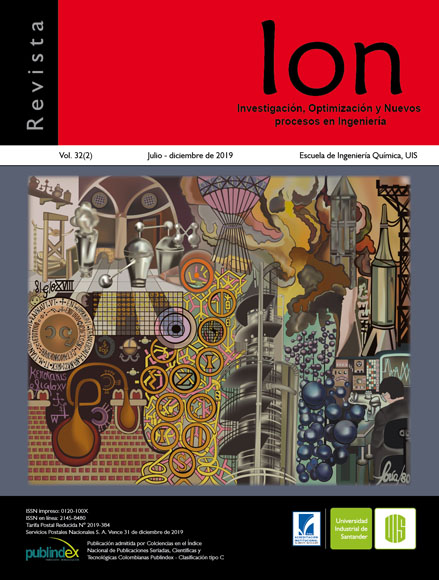Evaluation of hydrolyzed whey proteins as a nitrogen source in the lactic fermentation of lactose
Published 2019-11-12
Keywords
- Hydrolysates,
- Whey Protein,
- Fermentation,
- Lactobacillus Casei ATCC 393,
- Lactic Acid
- Yeast Extract. ...More
How to Cite
Abstract
A strategy for the utilization and valorization of whey proteins resulting from curd manufacturing process out of sour milk was evaluated. The stages of precipitation (thermal and acid denaturation) and enzymatic hydrolysis were considered for later use as a nitrogen source in lactose fermentation to obtain lactic acid. Tests were carried out modifying the hydrolysis pH and Temperature, finding a molecular size lower than 6.5kDa for the hydrolysates at a pH of 10 and 60°C. Such hydrolysates were used in lactic acid fermentation with Lactobacillus casei ATCC 393, at concentrations of 1% w/w and 7% w/w, using 1% w/w yeast extract as reference. Microbial growth (3.0*109 & 1.7*109 CFU/cm3), product/substrate yield (0.78 & 0.76 g/g) and productivity (0.41 & 0.30g/dm3.h) were similar for media with yeast extract and hydrolysate at 1%w/w, respectively, while hydrolysate at 7% w/w showed some inhibition, possibly related to high total nitrogen content in the medium, which was appreciated in the response variables already mentioned (5*108 CFU/cm3, 0.53g/g & 0.18g/dm3.h). These primary results show the potential use of this by-product in lactic fermentation.
Downloads
References
[2] Departamento Administrativo Nacional de Estadística (DANE) (2012-2015). Encuesta Anual Manufacturera (EAM). Bogotá, Colombia; 2019.
[3] Garcia CA, Arrázola Paternina G, Durango AM. Producción de ácido láctico por vía biotecnológica. Temas Agrarios. 2010;15(2):9-26.
[4] Miller C, Fosmer A, Rush B, McMullin T, Beacom D, Suominen P. Industrial Production of Lactic Acid. In: Comprehensive Biotechnology. Second Edition. Netherlands: Elsevier Inc.; 2011. p. 179–88.
https://doi.org/10.1016/B978-0-08-088504-9.00177-X.
[5] Mohseni J, Fazeli M, Lavasani AS. (2016). Effect of various parameters of carbon and nitrogen sources and environmental conditions on the growth of Lactobacillus Casei in the production of lactic acid. Global Journal of Medical Research: L Nutrition & Science. 2016;16(2):67-73.
[6] Amrane A. Batch cultures of supplemented whey permeate using Lactobacillus helveticus: Unstructured model for biomass formation, substrate consumption and lactic acid production. Enzyme and Microbial Technology. 2001;28(9–10):827–34. https://doi.org/10.1016/S0141-0229(01)00341-6.
[7] Serna L, Rodriguez A. Producción biotecnológica de ácido láctico: Estado del arte. Ciencia y Tecnología Alimentaria. 2005;5(1):54–65. https://doi.org/10.1080/11358120509487672.
[8] Panesar PS, Kennedy JF, Knill CJ, Kosseva M. Production of L(+) Lactic Acid using Lactobacillus casei from Whey. Brazilian Archives of Biology and Technology. 2010;53(1):219–26. https://doi.org/10.1590/S1516-89132010000100027.
[9] Nancib N, Nancib A, Boudjelal A, Benslimane C, Blanchard F, Boudrant J. The effect of supplementation by different nitrogen sources on the production of lactic acid from date juice by Lactobacillus casei subsp. rhamnosus. Bioresource Technology. 2001;78(2):149–53.https://doi.org/10.1016/S0960-8524(01)00009-8.
[10] Morr CV, Ha EYW. Whey protein concentrates and isolates: Processing and functional properties. Critical Reviews in Food Science and Nutrition. 1993;33(6):431–76. https://doi.org/10.1080/10408399309527643.
[11] Velásquez J, Giraldo G, Padilla L, Giraldo Y. Crecimiento de lactobacillus casei ssp casei ATCC 393 en suero clarificado. Biotecnología en el Sector Agropecuario y Agroindustrial. 2015;13(1):19–27.
http://www.scielo.org.co/scielo.php?script=sci_arttext&pid=S1692-35612015000100003&lang=pt.
[12] Vázquez Puente F, Villegas Arroyo G, Mosqueda Frías P. Precipitación de proteínas lactoséricas en función de la acidez, temperatura y tiempo, de suero producido en Comonfort, Guanajuato, México. Revista Venezolana de Ciencia y Tecnología de Alimentos. 2010;1(2):157-69.
[13] Coelho M, Silva M, Silva V, De Souza M, Lopes C, Afonso W. Analysis of whey protein hydrolysates: Peptide profile and ACE inhibitory activity. Brazilian Journal of Pharmaceutical Sciences. 2012;48(4):747–57. https://doi.org/10.1590/S1984-82502012000400019.
[14] Shu G, Zhang Q, Chen H, Wan H, Li H. Effect of five proteases including alcalase, flavourzyme, papain, proteinase k and trypsin on antioxidative activities of casein hydrolysate from goat milk. Acta Universitatis Cibiniensis Series E: Food Technology. 2015;19(2):65–74. https://doi.org/10.1515/aucft-2015-0015.
[15] Adler-Nissen J. Enzymic hydrolysis of food proteins. New York, Unites States: Elsevier Applied Science Publishers; 1986.
[16] Spellman D, McEvoy E, O’Cuinn G, FitzGerald RJ. Proteinase and exopeptidase hydrolysis of whey protein: Comparison of the TNBS, OPA and pH stat methods for quantification of degree of hydrolysis. International Dairy Journal. 2003;13(6):447–53. https://doi.org/10.1016/S0958-6946(03)00053-0.
[17] Ghosh BC, Prasad LN, Saha NP. Enzymatic hydrolysis of whey and its analysis. Journal of Food Science and Technology. 2017;54(6):1476–83. https://doi.org/10.1007/s13197-017-2574-z.
[18] Perea A, Ugalde U, Rodríguez I, Serra JL. Preparation and characterization of whey protein hydrolysates: Applications in industrial whey bioconversion processes. Enzyme and Microbial Technology. 1993;15(5):418–23. https://doi.org/10.1016/0141-0229(93)90129-P.
[19] Galvão CMA, Silva AFS, Custódio MF, Monti R, Giordano RDLC. Controlled hydrolysis of cheese whey proteins using trypsin and α-chymotrypsin. In: Davison BH, McMillan J, Finkelstein M. (eds). Twenty-Second Symposium on Biotechnology for Fuels and Chemicals. United States: Humana Press; 2001. p. 761–776. https://doi.org/10.1385/ABAB:91-93:1-9:761.
[20] Prieto C. Diseño y optimización de un reactor de membrana discontinuo para la hidrólisis enzimática de proteínas. (Tesis de doctorado). Granada, España: Universidad De Granada; 2007.
[21] Zheng H, Shen X, Bu G, Luo Y. Effects of pH, temperature and enzyme-to-substrate ratio on the antigenicity of whey protein hydrolysates prepared by Alcalase. International Dairy Journal. 2008;18(10–11):1028–33. https://doi.org/10.1016/j.idairyj.2008.05.002.
[22] Polaina J, MacCabe AP. Industrial Enzymes: Structure, Function and Applications. The Netherlands: Springer; 2007. https://doi.org/10.1007/1-4020-5377-0.
[23] Castro A. Caracterización del proceso de obtención y separación de ácido láctico a partir de la fermentación de suero lácteo utilizando la tecnología de membranas. México: Universidad Autónoma De Querétaro; 2011.
[24] Ghaly AE, Kamal MA. Submerged yeast fermentation of acid cheese whey for protein production and pollution potential reduction. Water Research. 2004;38:631–44. https://doi.org/10.1016/j.watres.2003.10.019.
[25] Altıok D, Tokatl F, Harsa S. Kinetic modelling of lactic acid production from whey by Lactobacillus casei (NRRL B-441). Journal of Chemical Technology & Biotechnology. 2006;82(May):1115–21. https://doi.org/10.1002/jctb.
[26] Büyükkileci AO, Harsa S. Batch production of L(+) lactic acid from whey by Lactobacillus casei (NRRL B-441). Journal of Chemical Technology and Biotechnology. 2004;79(9):1036–40. https://doi.org/10.1002/jctb.1094

